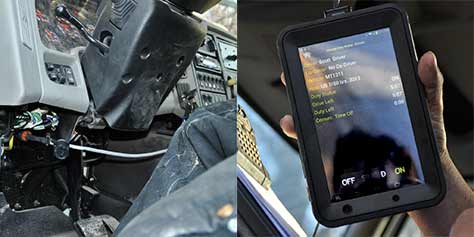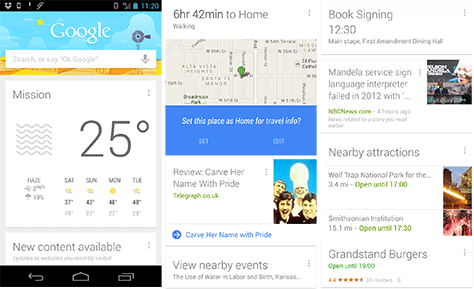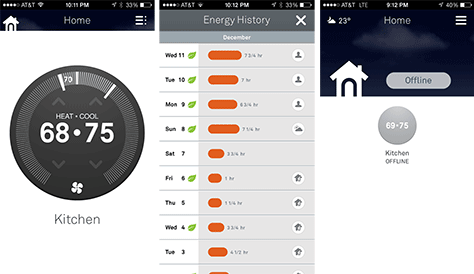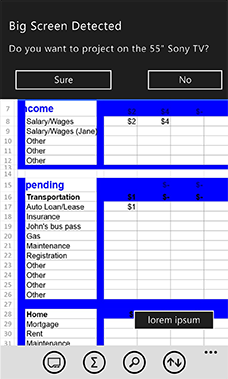We like to distinguish between the environmental and situational contexts of people regardless of the device. Sitting at a desk is different from being slouched in the living room or repairing a truck. Interactions in all of these contexts are important, whether they happen on a notebook or desktop computer, a mobile device, or bit of paper.
Context via New Technologies?
A key tenet of our digital life is that software controls everything digital. The principle behind the Internet of Things is that we can sensorize and connect every dumb thing and, thus, reap the benefits of digital in the real world. Now, we’ll be able to control everything with software. If we can digitize, search for, and analyze everything, we won’t lose things anymore, and trends won’t remain undiscovered.
Despite the term’s Internet of Things (IoT) existing since 1999, only in the last few years has this been a real possibility. Now, it’s easy to get excited about the IoT, so people are waxing philosophical about its current state and the possibilities the future might bring. Robert Scoble has even written a whole book on the world of connectivity, sensors, and so forth. He refers to this trend as the Age of Context.
The technologies he mentions—such as wearables, big data, sensor proliferation, and location awareness are indeed great, revolutionary things that we should all be aware of. Such products cannot fail to impress us; products like Nest’s thermostats and smoke detectors and Apple’s iBeacon service to enable better interior-location awareness, not to mention smartwatches and exercise bands.
The Internet of Things is far enough along that we’re well into the first wave of copycats. There are now many Internet-connected light bulbs, and every big thermostat-maker has a connected, smart version. A reporter covering CES said, “I would estimate the number of fitness and data-tracking wristbands at … infinite.”
But we are still mostly disappointed by the IoT—and low consumer usage seems to bear us out. We have the technology, but we keep using it in narrow, short-sighted ways. In fact, hardly anything we see is truly Internet connected. While you really can control that light bulb from your phone, more often than not, you can’t control it from nothing else. Is this really being Internet-connected? As Liat Ben-Zur said way back in May 2013:
“So what’s the problem? Aren’t all these hot, new connected IoT devices connected up to the cloud? Well, that’s the problem. We are oversimplifying the landscape. Each specific device seems to connect to its particular cloud service. There isn’t really one cloud. Every manufacturer has their own cloud service, and often these clouds are closed, proprietary environments. Devices that live in their own siloed cloud cannot speak to one another, meaning they cannot benefit from the data, context, or control of nearby IoT devices.”
You can discover this for yourself. Find anything that connects by Bluetooth to a smartphone. Almost all products work exclusively on either iOS or Android. Check out how you can use the data on your smart, connected widget. It either connects to your phone alone or, at best, to a proprietary database with no open API. These technologies don’t define context themselves. They are enabling technologies, not the end goal. The problems that we have today are endemic.
Where Are the People?
We all know that there are sensors, even if we’re amazed at what we could do with them. But how many people are building ecosystems? Are these technologies getting built because users need them or just because we can build them? What makes you choose a particular technology or platform? The CEO of the big chip maker ARM, Simon Segars, said recently, “Most IoT applications are so narrow, with one device only talking to one service.... We need these items to talk to each other more, in order to prevent an Internet of silos.”
Some of the organizations that we’ve worked with are trying to take advantage of the new world of sensors and connectivity by gathering and exposing more information; but not always in a very consolidated, much less a user-centered manner. Just as an example, one client is launching two different Bluetooth-connected devices—that is, a single company has two totally different devices that are unaware of each other and require different apps on the mobile device to connect to the Internet. Naturally, their data is stored in two different databases that don’t connect to each other either.
Every organization and many individuals want the benefits of information awareness, so they either tolerate poor solutions or come up with their own. As you can see in Figure 1, a trucking company hacked together cable from the J1939 diesel-diagnostics connector and plugged it into to a Galaxy Tab, so the driver and his company could log progress, track vehicle use, and reduce paperwork.

Such tracking systems will soon be required by law, but it’s just on the cusp of being easy to do, by adding a radio or cable. The smartness of trucks, which have been full of computers and sensors for years now, and the smartness of mobile devices can work together.
Context Is About Ecosystems
But what people really want are seamless solutions. They don’t want to think about technology. The power of the IoT is in seamless communications, not constant pairing with Bluetooth devices or reading the side of a light-bulb box to figure out what mobile-phone operating system (OS) it’s compatible with. Tactically, if your first design task is to decide whether to create a Web site or an app or which OS to support, you’re doing it wrong. People switch operating systems and households are mixed. Design a solution as a service, with APIs, data storage, and concepts for how people will use it before picking the colors for its buttons.
We haven’t discussed Google Glass yet—basically because for now it’s so niche and one off that it’s hard to say much about it. But one key part of Glass is really becoming a universal service. Google Now is on Glass, but is also an increasingly seamless part of Android and is available for iOS. Plus, the Google Web site![]() makes me suspect that they are going to launch it there sometime. The primary user interface for Google Now, shown in Figure 2, is a series of cards presenting information that is based on your context and past behavior. Sometimes, it gets confused—for example, offering me a 7-hour walk home from the airport.
makes me suspect that they are going to launch it there sometime. The primary user interface for Google Now, shown in Figure 2, is a series of cards presenting information that is based on your context and past behavior. Sometimes, it gets confused—for example, offering me a 7-hour walk home from the airport.

Google Now is a service that is embedded in the current Android OS. In one way, it’s a search-portal home page like Yahoo!—and not quite like anything Google has done before. It is even tying into other services, allowing you to send an SMS just by talking to this one voice-enabled, sensor-aware portal. But it is most interesting in the way it proactively does things based on what it knows about you.
The way it monitors all that you do using all Google services is cause for worry in some. It seems to know everything about you. But, if anything, we are disappointed that it knows so little. We are regularly enticed to go visit a favorite restaurant that is 2,000 miles away, perhaps when we’re in the middle of a meeting. Google Now’s connection to location, calendars, and users’ recent behavior is pretty tenuous, so it’s not as smart as it should be.
Steven’s wife, Alison, in a fit of nerdiness, set up IFTTT to notify her when the local weather gets near freezing—so she can be sure to seal up the greenhouse and put the heater on—despite the fact they have digital thermometers strewn about the house, not to mention many mobile phones and tablets. Even if they spent the not-inconsiderable time and effort to set up a greenhouse thermometer that connected to the Internet, it would be just one more thing that Google Now is unaware of. In an ideal world, Google would use the knowledge that we know they have: that Alison is a serious gardener and has a greenhouse and the weather data to push notices via Google Now that it’s going to be freezing tonight.
Nest thermostats connect to local utilities via the Internet and adjust automatically in sync with a demand-response scheme. Setting aside any concerns about your electrical utility rather than you having control of your house, that’s all it does. There’s little awareness or notification, and there’s not really a proactive control measure for the user to do anything about this.
Even with such coordination, why isn’t the data on the Internet tied to our accounts, so right under the Weather card in Google Now we could see a Home card with thermostat settings, trends, and the utility’s demand-response points? Nest lets you establish a relationship to their physical thermostat in the app settings and provides useful visibility to trending data. But the Nest shown in Figure 3 is not connected, as you can see on the right, and a user cannot connect it from the app.

Half the time anyone pulls up their Nest app in front of me, it’s in an error mode like that shown in Figure 3. Most or all connected devices such as Nest, Pebble, ChromeCast, DishEverywhere, Smart TVs, and BD players aren’t very good at staying connected, so require users to walk over to the device and push buttons or pull cords out of the wall. Wireless connections are inherently unreliable, so devices and software need to be less brittle, especially if a key reason for their existence is place shifting, or remote operation.



